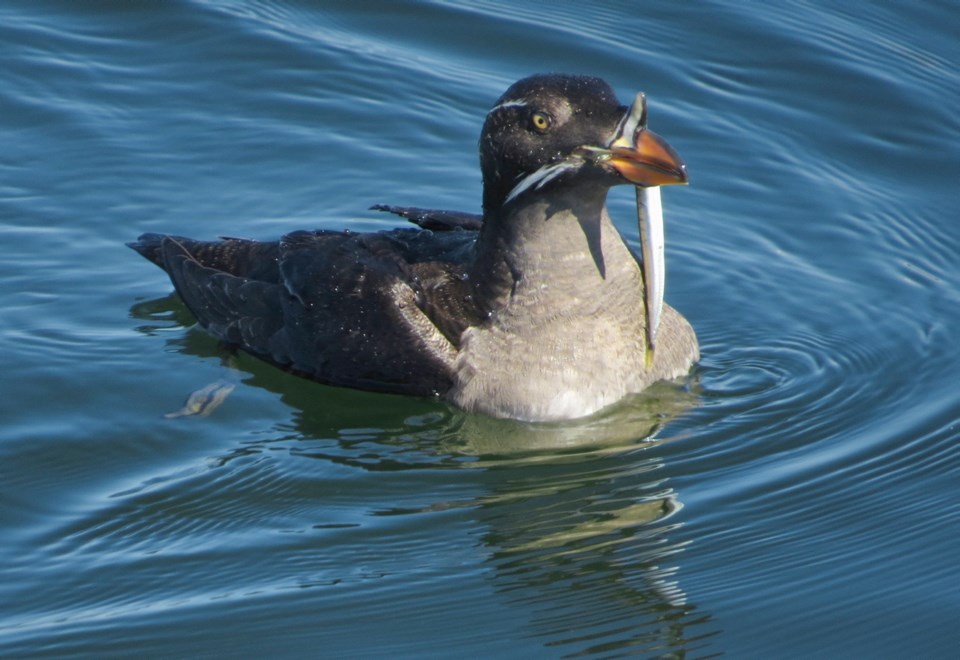Nature is wondrously complex. Who would have thought that a carelessly built seawall could imperil distant salmon, marbled murrelets, and orcas?
Yet, the Washington State Orca Task Force pinpointed this curious link.
Here’s the way it works. Surf smelt and Pacific sand lance — forage fish that play a crucial role in marine food webs — reproduce by gluing their eggs to grains of sand and gravel. But seawalls reflect waves and wash away beaches. When sand and gravel beaches are destroyed by seawalls, local fish spawning collapses.
Loss of sand lance directly affects the seabirds that depend on them — such as rhinoceros auklet chicks in the Strait of Juan de Fuca and threatened marbled murrelets of the Sunshine Coast. Loss of smelt and sand lance also undermines the salmon populations essential to survival of southern resident orcas.
WWF-Canada recognizes that loss of spawning beaches is a key ecological threat. Indeed, only about 12 per cent of the Salish Sea coastline is likely spawning habitat — and this precious resource is being lost to burgeoning development. Unfortunately, sea-level rise — exacerbated by things like seawalls — is likely to substantially diminish the quantity and quality of spawning beaches.
As a result, WWF is working with partners to identify and map B.C.’s crucial fish spawning beaches (which have already been mapped in Washington state).
It is now crucial that the province follow Washington’s lead on another front. B.C. needs to strictly regulate the construction of seawalls (and rip-rap boulder walls) above sand and gravel beaches. Thus far, B.C. has failed to do so — leaving regulation of shoreline development to the discretion of local governments.
This has created a patchwork of inconsistent and inadequate shoreline protection rules. Worse, a recent B.C. court decision struck down the jurisdiction of local governments to effectively regulate shoreline development. Provincial action is long overdue.
As detailed in a recent University of Victoria Environmental Law Centre Report, B.C. needs to follow the example of Washington State and adopt a Shoreline Protection Act to:
• Protect fish spawning beaches. For example, the act should require local governments to establish protective areas that require permits for development above sensitive beach spawning habitats.
• Require shoreline owners to employ best practices for ecologically sensitive shoreline protection. Seawalls and rip-rap are simply archaic. They need to be replaced by modern “Living Shoreline” techniques that use natural material (plants) to stabilize the shore. Both the province and Washington state already detail such techniques in practical landowner guidebooks.
• Require “no net loss” of marine shoreline ecological function, when development takes place. If loss is unavoidable, compensatory beach habitat must be provided. We can learn from current beach restoration projects, where beaches are re-established by adding sand.
• Provide tax incentives to property owners to enhance and protect fish spawning beaches. Several jurisdictions provide tax breaks to owners for dedicating portions of their land to conservation. Such breaks should be made available to every owner who chooses to enhance protection of land above key spawning beaches.
Spawning beaches are a vibrant, living part of the Salish Sea — we cannot allow them to disappear. We have a moral responsibility to pass the Salish Sea intact to our great-grandchildren.
If we act, a century from now children will still revel at the sight of a rhinoceros auklet and its quirky beak stuffed with Pacific sand lance for its chicks. Marbled murrelets will still wing through the shaded old growth of the Sunshine Coast, carrying sand lance from distant waters to their young.
And (if we deal with vessel traffic and other threats to orcas), children might still see the monarchs of the deep leap into the air and capture human hearts.
Calvin Sandborn is legal director of the UVic Environmental Law Centre, and Jacklyn Barrs is a marine conservation specialist with World Wildlife Fund Canada.



